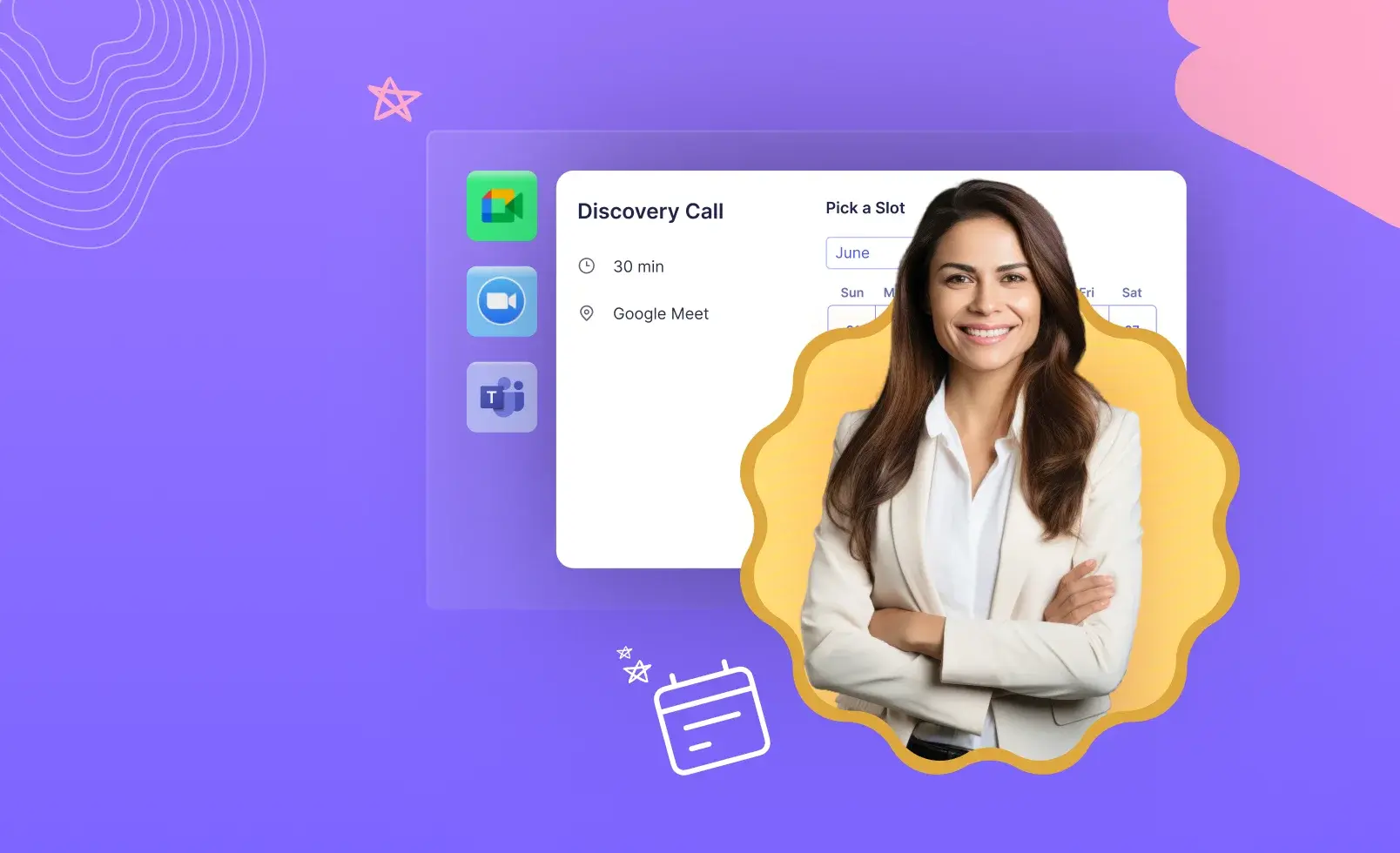You’ve successfully won over a prospect and the next step is to book a meeting with them to take them to the next step of the sales process.
How do you do that? You likely check their availability and offer them a selection of time slots to choose from.
They might not be comfortable with the slots you offered. The time that suits them might be a busy slot for you. Alternatively, they might get connected to a sales representative who lacks experience in handling their specific type of prospect. And so on.
This back-and-forth process before finalizing and booking a meeting can be tedious for you and your prospect.
Fortunately, these inefficiencies can be eliminated if the appointment scheduling process is automated with appointment scheduling software.
In this blog, we'll explore what the appointment scheduling process is, including its steps and challenges along with how it can be automated. Buckle up!
What Is Appointment Scheduling?
Appointment scheduling is the process of booking a meeting with a prospect by allotting a specific time slot. Here are some instances where appointment scheduling comes into play:
- Sales development representatives (SDRs) book meetings when a prospect shows interest in buying your product.
- Inbound prospects might talk with SDRs to book meetings, with an intention to see a demo of the product and understand how it works.
- Customer success teams book meetings to follow up and provide post-sales support for customers and so on.
Appointment scheduling has become a vital part of the sales process and must be done correctly to avoid losing potential customers.
How Does Appointment Scheduling Work?
The appointment scheduling process typically involves the following 3 steps:
Step 1: Informing the potential prospect of available time slots, allowing them to select the one that suits them best.
In this step, sales reps will provide the prospect with a list of available time slots for the appointment. This can be done through:
- A web-based calendar interface that displays available time slots.
- An email or SMS notification with a list of available time slots.
The prospect can then select a time slot that suits them best.
Step 2: Confirming the preferred time slot and securing it for the meeting.
Once the prospect has selected a time slot, the sales rep will confirm the selection and secure the time slot for the meeting. This involves sending a confirmation email to the prospect with the details of the appointment (date, time etc.).
This step ensures that the appointment is officially booked and that all parties involved are aware of the details.
Step 3: Sending reminders for the scheduled meeting.
In this final step, the reps send reminders and notifications to the prospects to ensure they are prepared for the meeting. This can include:
- Reminder emails or SMS notifications to the prospects with details of the appointment.
- Automated reminders to the prospects to confirm their attendance or to provide any necessary information. These notifications are instrumental in reducing no-shows.
Challenges Faced in Manual Appointment Scheduling:
There are numerous challenges that you may encounter during the manual appointment scheduling process, and being aware of them is crucial to avoiding these obstacles successfully.
The common 3 challenges that occur while manually scheduling appointments are:
1) It Drains a Lot of Time:
A prospect has to visit your company’s website and fill out a form. You then need to review the details, qualify the prospect, and assign a sales representative to contact the prospect.
Given this long-drawn nature of the appointment scheduling process, executing it manually can take a lot of time.
This time delay can cause the prospect to lose interest or seek alternative solutions, which is a common challenge faced by B2B sales businesses.
2) It’s a Bumpy Ride for the Prospect:
Let's say a prospect has booked a meeting with you. However, after the initial booking, the prospect becomes busy at the previously scheduled time slot and wants to reschedule their appointment.
To do this, they need to contact you again, discuss available time slots, and wait for you to confirm their availability.
This entire process typically unfolds over a series of back-and-forth across calls or emails, resulting in a poor experience for the prospect.
And research shows that 43% of customers are more likely to make a purchase after a positive customer service experience. So, it’s crucial to make the appointment scheduling process as smooth as possible.
3) Getting Connected With the Wrong Rep
During the appointment scheduling process, there is a high likelihood of prospects being routed to an unsuitable sales representative.
For instance, if a prospect from the healthcare industry is mistakenly routed to a sales representative who has not handled a healthcare prospect before, there is a significant risk of losing the prospect due to the representative's lack of expertise in handling enterprise prospects.
This is a common challenge faced by the sales team, as they must manually review the data, determine the type of client, find a suitable sales representative, check their available time slots, and match them accordingly and the process is prone to human error.
So, how do you sidestep these challenges in appointment scheduling?
By using appointment scheduling software to streamline your scheduling requirements from start to finish.
What Is an Appointment Scheduling Software?
An appointment scheduling software is a tool that companies use to automate the process of scheduling appointments with potential clients.
Prospects can use the appointment scheduling software to book, reschedule, or cancel appointments with just one click. These software tools can be integrated with the calendars, making the process hassle-free.
Implementing an appointment scheduling software has proven to be beneficial for companies as it eliminates time drain, increases productivity & reduces the occurrence of incorrect bookings.
Typically, when an appointment is booked, but not properly followed up or kept track of, there is a risk of double-booking, which means booking two different appointments for the same time slot. But using an appointment scheduling software can completely eliminate these issues.
According to a recent research, 46% of the appointments usually are booked online. So equipping an appointment scheduling software would be the right decision.
6 Key Features You Should Look for in an Appointment Scheduling Software:
When it comes to choosing an appointment scheduling tool, these are the set of features you should be looking for to make sure it caters to all your scheduling automation needs: .
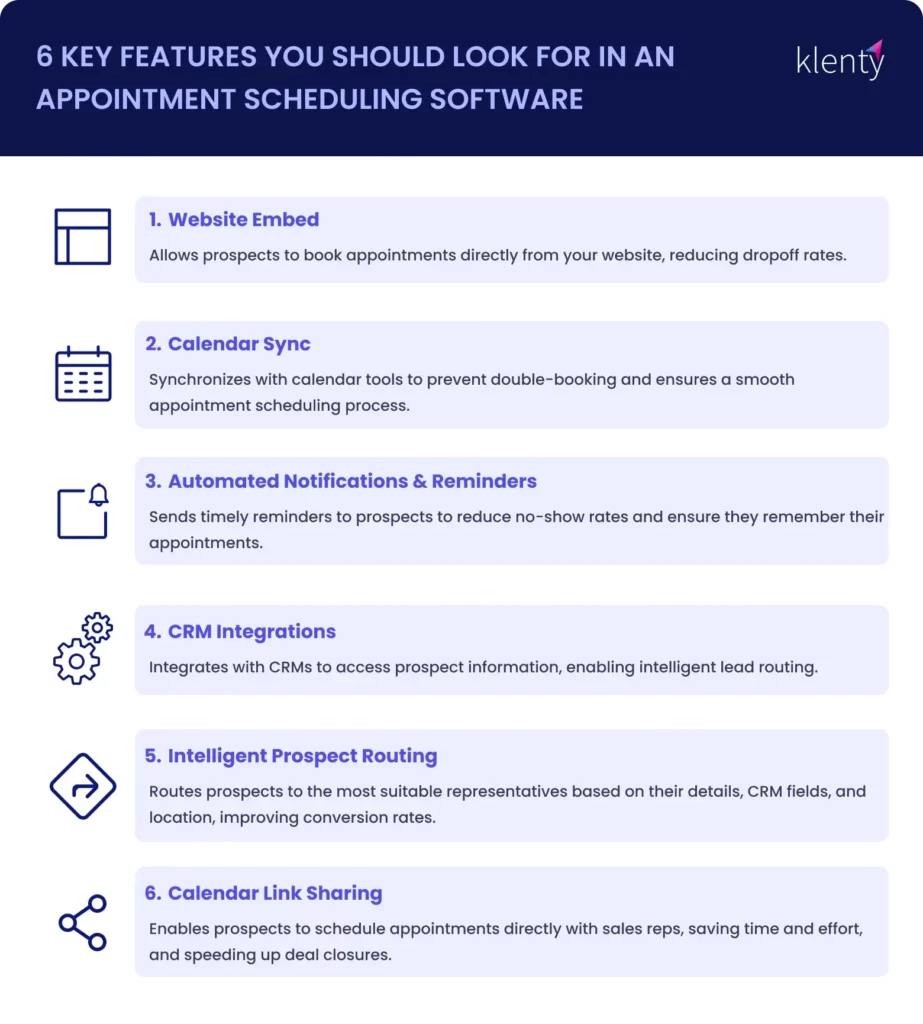
1) Website Embed
The website embedding feature in appointment scheduling software enables prospects to book appointments directly from your website. How?
The software allows you to embed either a booking widget or a form on your site.
By offering this functionality within your website, you prevent prospects from navigating to a different site, thereby reducing the dropoff rate.
At the end of the day, this allows prospects to schedule appointments conveniently, without leaving your website.
2) Calendar Sync
This feature of an appointment scheduling software enables synchronization with calendar tools such as Google Calendar and Outlook Calendar.
When a prospect visits your website and clicks on the "Book a meeting" button, a calendar pops out with available time slots.
The prospect can then select the desired time slot, which reduces the likelihood of double-booking or missing previously scheduled appointments.
Double-booking can be a headache because one time slot may be allocated for the purpose of meeting with two different prospects. This can lead to confusion and inconvenience for both parties involved.
If one of the prospects decides to cancel their appointment due to the scheduling conflict, that's a loss for the business.
Calendar syncing allows coordination to occur in a single location, which streamlines the appointment booking process. The time-consuming process of where the prospect and sales rep exchange emails or calls to agree on a meeting time, gets eliminated.
The sales team can focus on other critical tasks, such as following up with leads, closing deals, and providing excellent customer service.
3) CRM Integrations
This feature of the Appointment Scheduling Software that allows it to integrate with CRMs is vital for various reasons.
During the lead qualifying and routing process, the software needs to access as much information as possible to perform actions intelligently.
With this feature, the scheduling software can access the CRM fields and ownerships to gain a better understanding of the prospect and route them intelligently.
Another good thing is that every information about the prospect can stay in one place for the rep, making it hassle-free to use. The rep can access all the necessary information about the prospect, such as their contact details & previous interactions without having to switch between different tabs.
4) Automated Notifications & Reminders
Sales representatives speak with numerous prospects in a day, and there is a possibility that the prospect is also engaging with multiple sales representatives.
When an appointment is booked, there are a lot of chances for the prospect to forget about the appointment. This might result in a no-show from the prospect side.
Surely, you don't want to lose a solid prospect who has a high chance of purchasing your product, do you?
Appointment scheduling sends automated notifications and reminders to the prospect in advance via email, phone call, or text message, giving them a constant heads-up regarding the appointment.
As a result of this, both you and the prospect get constant reminders on the meetings resulting in them always having a thought about the meeting at the back of their head.
A study shows that the no-show rates have dropped by 90% with the help of timely appointment reminders. So hey, it’s better to have it done right.
5) Intelligent Prospect Routing
This feature can smartly route prospects to their suitable representatives. Let's see how it works.
For example, when a prospect enters their details, with the help of this feature, the appointment software assesses the form answers, CRM fields, ownership, and location (based on their IP address).
It then routes the prospect to the most appropriate and suitable representatives for handling them.
With the help of this feature, the failure rate is drastically reduced, making it one of the must-have features for appointment scheduling software.
The right prospect will be routed to the right representative, resulting in improved lead qualification and conversion rates.
6) Calendar Link Sharing
With this feature, you can say goodbye to the endless conversation to book a meeting. This allows the appointment scheduling software to share your calendar link with prospects, enabling them to schedule appointments directly with you.
This saves you a lot of time and effort. No more back-and-forth emails or phone calls trying to find a mutually convenient time.
Apart from that, the feature also helps you speed up deal closures by letting prospects easily book meetings at their convenience. This means that you can spend less time scheduling and more time closing deals.
If you’re looking for an appointment scheduling software which has all the above-mentioned features, then look no further. Schedule IQ by Klenty has it all.
How Schedule IQ Enhances Appointment Scheduling for Businesses
Schedule IQ by Klenty is an appointment scheduling software that can help businesses save time, improve sales efficiency, and generate high-quality leads by automating the scheduling process.
So how can Schedule IQ do that?
- Calendar Syncing:
Schedule IQ can be integrated with calendar tools such as Google and Outlook Calendars, which significantly streamlines the appointment booking process.
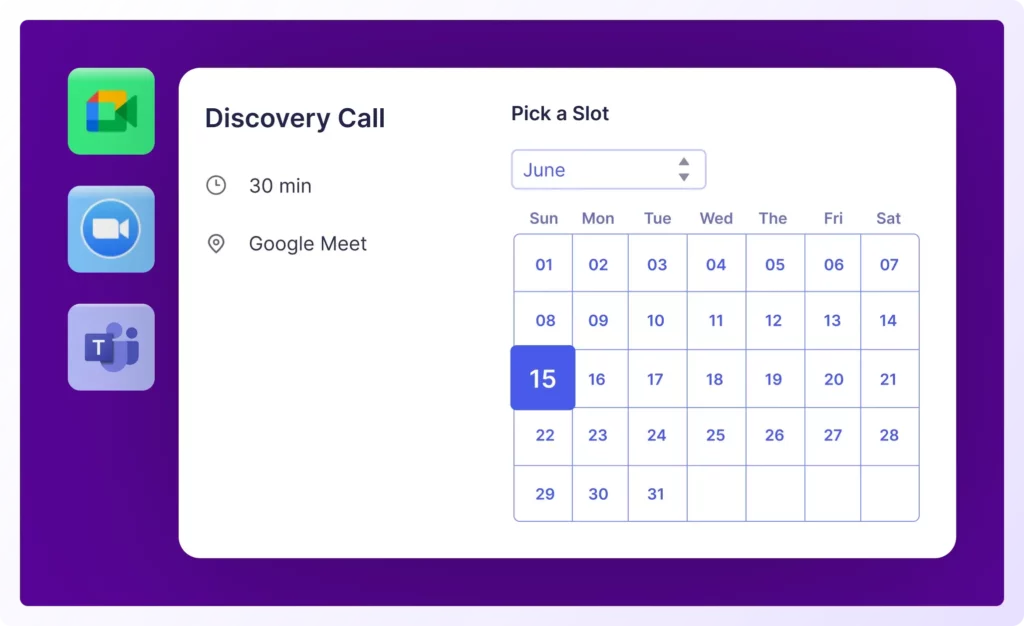
With just one click, the appointment is booked with the right sales representative.
- Smart Lead Routing:
Based on the form answers filled by the prospect, information in CRM fields, CRM ownership & location (which is identified with the help of the prospect’s IP address), Schedule IQ identifies the type of prospect and routes them to the appropriate sales representative.
It offers 4 advanced routing methods, namely:
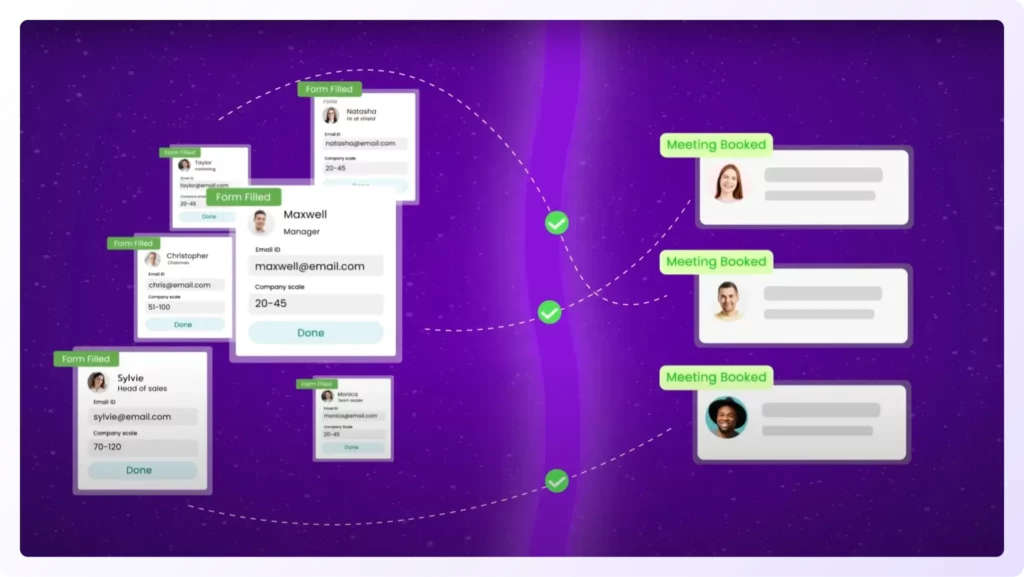
1. Owner-based Routing: Suppose a prospect is mistakenly considered new, but they've already been in contact with the company and assigned to a different sales rep.
Schedule IQ quickly checks the CRM data and routes the prospect to their original owner, preventing duplicate efforts and improving the customer experience.
2. Form-based Routing: Based on the answers which the prospect fills in the forms for the questions such as the company size, tech stack, location etc, the software routes them to the suitable representatives.
3. CRM-based Routing: Schedule IQ assesses the CRM details of the prospect and leads them to the suitable representative who will be able to handle them effectively.
4. IP-based routing: Schedule IQ can identify the location of the prospect by accessing their IP address and routes them to the rep who is based out of the same location.
- Automated Follow-Ups:
This way, prospects are matched with sales representatives who are familiar with their local market providing a better customer experience.
If the prospect wishes to reschedule the appointment, there is no need for a lengthy back-and-forth conversation. Schedule IQ can trigger follow-ups based on the scenarios such as dropoff at form, calendar or meeting cancellation.
- Smart Lead Distribution:
Schedule IQ uses various methodologies to smartly distribute the incoming prospects to the suitable representatives.
Schedule IQ software uses 3 distribution methods namely,
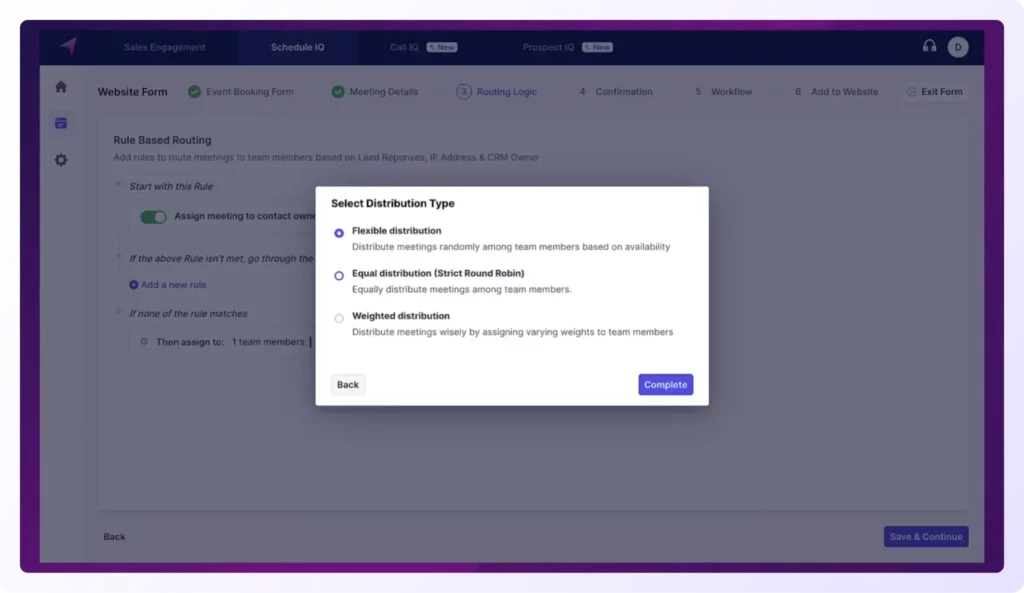
1. Flexible Distribution: This routing method allows you to distribute meetings based on the availability. So, the prospect will be routed to the rep who has the soonest availability randomly.
2. Equal Distribution: This routing method allows you to allocate an equal number of meetings among your reps irrespective of their skill level.
3. Weighted Distribution: This routing method lets you route meetings based on the skill level of the sales reps. The rep with the higher skill level receives more prospects.
Thus, Schedule IQ enhances the appointment scheduling process and ultimately helps you yield more closed-won deals and revenue growth.
If you want to experience how Schedule IQ works, book a demo with us right now!
FAQ
1. What Is the Most Commonly Used Appointment Scheduling Software?
2. What Are the Pros and Cons of an Appointment Software for Scheduling?
- Improves prospect’s experience.
- Meetings can be booked right away.
- Wait times are reduced.
- No-shows are reduced with the help of reminder triggers.
Cons:
- Implementing new software may necessitate training and a learning curve for the team.
- Technical difficulties like downtime can occur.

